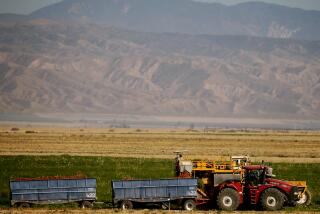The Year in Review: Revisiting the notable Valley events of 1994. : Water Plan to Aid Valley Doesn’t Wash With Some : Utilities: Proposal to lower rates for many local users faces opposition from South and Central Los Angeles.
Throughout 1994, a behind-the-scenes battle brewed at City Hall that will soon put the Valley’s political muscle to the test in a fight over life’s basic necessity: water.
In response to a flood of calls from outraged San Fernando Valley residents complaining about huge water bills in the summer of 1993, city officials and citizens panels spent the past year drafting a new formula for calculating water rates they hope will be equitable to all users.
The formula, which is scheduled for the City Council’s consideration in mid-January, would provide relief to residents who have big households, large lots or live in hot climates--three breaks that will benefit Valley users.
But battle lines have already been drawn over the formula, and opposing factions are retrenching for a water fight that will affect the rates of nearly 400,000 Department of Water and Power customers in Los Angeles.
While Valley representatives support the formula, council members from South and Central Los Angeles criticize it, calling it a flawed proposal that forces some users to subsidize the water habits of others.
“There is some concern about its impact on South-Central because the bottom line is, it will increase the rates for residents in South-Central,” said Howard Gantman, spokesman for Councilwoman Rita Walters, who represents parts of South-Central Los Angeles.
But Councilwoman Laura Chick, who represents portions of the West Valley, supports the proposal, saying it will provide relief for Valley residents who have paid exorbitantly high bills under the current rate structure.
“I don’t see this as a struggle between the Valley and the rest of the city,” she said. “I see it as a way to right inequities.”
The stage was set for the upcoming clash in early 1993 when the city adopted a two-tier rate structure that was designed to promote water conservation by imposing a high rate for customers who use more than twice the median amount of water and a lower rate for more frugal users.
But when the higher rate took effect, Valley water users deluged City Hall with phone calls and letters, complaining about water bills that, in some cases, jumped as high as $900 and surpassed mortgage bills.
Valley voters, who had played a key role in electing Mayor Richard Riordan, demanded that he do something. They argued that the two-tier structure was unfair to Valley residents who use more water because they have larger lots and live in a hotter climate.
In September, 1993, Riordan reconvened the Mayor’s Blue Ribbon Committee on Water Rates--the same panel that drafted the two-tier structure--and instructed the group to review the formula in light of the Valley’s complaints.
The panel decided in June, 1994, to keep the basics of the two-tier formula in place to promote conservation. But the committee included breaks for residents who have large lots, big families or live in hot climates.
For example, a family of seven living in Woodland Hills--a “hot” climate zone--on a lot that is just under an acre can use 23,250 gallons a month in the winter and 41,250 a month in the summer before the higher rate kicks in.
In contrast, a family of two living on a lot smaller than 7,500 square feet in South-Central Los Angeles, a “moderate” climate zone, can use only 10,500 gallons a month in the winter and 13,500 gallons a month in the summer before the higher rate takes effect.
After adding a minor revision, commissioners on the Board of Water and Power voted in November to back the new water rate formula and sent it to the council for final approval.
Jerry Gewe, a DWP spokesman, played down the Valley breaks, saying that about 70% of water customers would see no change in their bill under the new formula. All other customers, he said, would only see a change of a few dollars a year.
“It’s not truly a Valley-versus-city issue,” he said, “but it’s being seen that way.”
Councilman Hal Bernson, whose northeast Valley district includes many residents who would benefit from the formula, said he will support the new plan. But he predicts a heated political battle to get the formula adopted.
“That’s the way it is and that’s the way it’s going to be,” he said.
More to Read
Sign up for Essential California
The most important California stories and recommendations in your inbox every morning.
You may occasionally receive promotional content from the Los Angeles Times.











